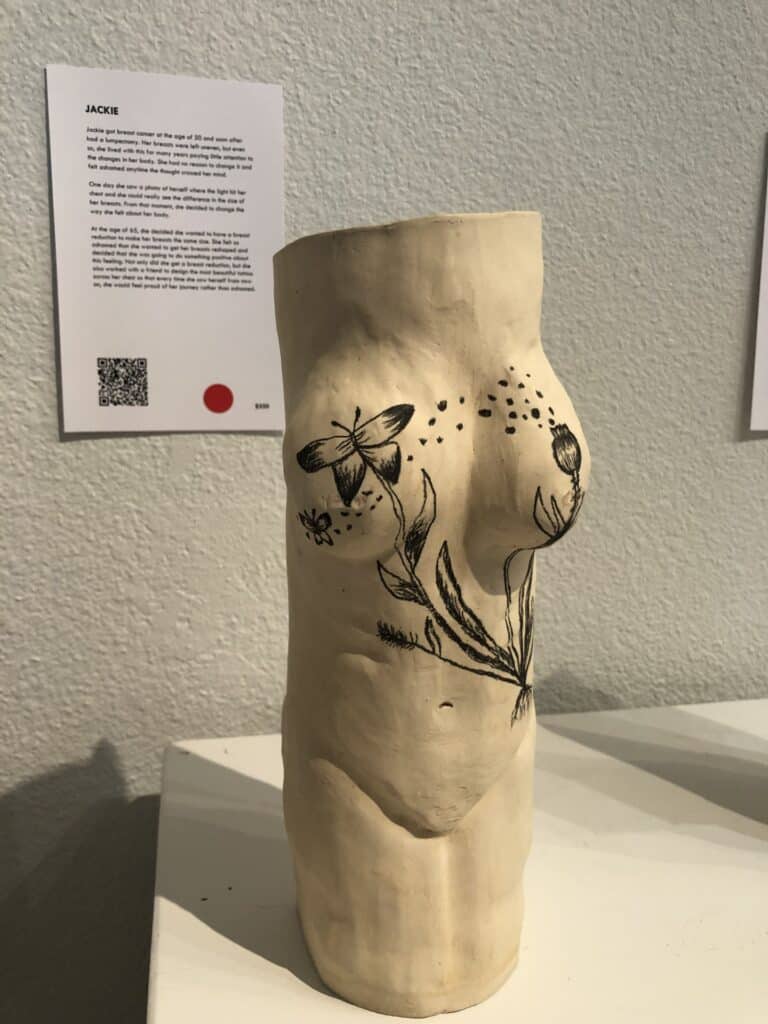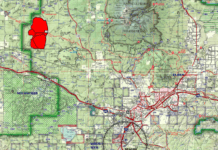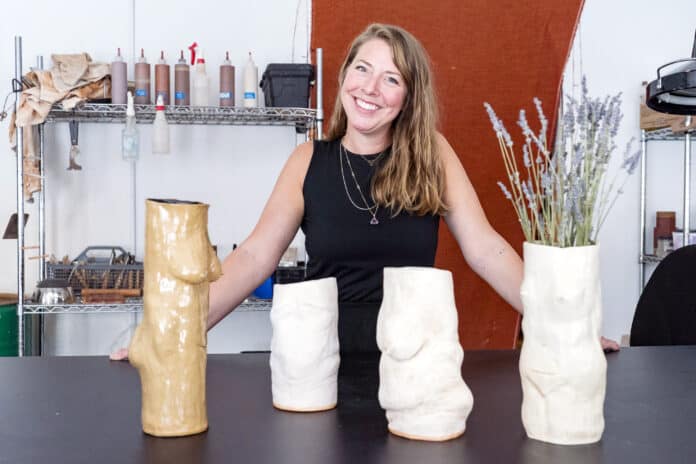Becky Altman enjoys the art of storytelling. Innately curious, she is intrigued by people’s stories and believes those stories shared can be healing, inspirational, educational and at the same time, exposing life’s intimate moments. What she has learned is that life is perfectly imperfect. According to Altman, women especially, are judged by those imperfections.
“Look at magazines and social media about how we should be seen as women like being perfect, a certain size and all of it is fake — everything’s photoshopped,” Altman said. “That’s not done with men as much, at least from my perspective.”
Altman, an artist and health and wellness coach, is interested in changing that narrative. She will be exhibiting her ceramics in the “Every Body is SOMEBODY” show on Friday, Aug. 4, at the Rovang Ceramics Studio in West Sedona.
The exhibit features 42 sculptures of the female body that represent real women. Over the past few months, Altman has been collecting stories from women, such as discussing why one chooses not to have children, or other experiences being objectified by men. Others have survived breast cancer, and some are struggling with trauma. Each woman has a different story to share, Altman said, each body type is different, yet each has felt that they are defined by their appearance, the blueprint of who they are.
“Most of the women who have talked to me about what they’ve been through — [it] has been such an intense experience with survival as the theme,” Altman said. “The main concept is that life is precious, and we need to appreciate the fact that we have had this kind of really dark experience that [may have] happened. It makes us appreciate more and gives us so much more gratitude.”
Altman said that all she wants to do is listen to people’s stories all the time.
“Now I’m creating things that actually can connect to people’s stories. I love that idea of having a space where people can come and read the stories and then want to talk about it,” she said.
The clay sculptures are faceless and focus on capturing the nature of women’s bodies of different shapes and sizes. Some have sagging body parts and others have scars, revealing the imperfections of every body type.
“This young girl, who was 6 or 7, saw me working on a piece,” Altman said. “I showed her the rest of them and asked, which one’s your favorite? She pointed to one ‘because it looks like my mommy’ and it’s the one that has a C-section scar and stretch marks. I think we just have such a jaded view of how we perceive what we actually look like and other people can see us in such different ways.”

Altman said that she cries reading the stories that women share.
“It’s seeing someone’s story from their perspective … and the experience of stepping into someone’s shoes and really understanding what they’ve been through and this is just a snippet of their story,” she said. “For me, it’s very emotional, being empathetic and feeling what that experience is.”
Altman added that she feels a personal connection to many of these stories and can relate them to the experiences of someone she knows, or herself.
“Oh, this is what this person must have felt like, this is what my grandma must have felt like, this is what my mom felt like,” Altman said. “You always find someone that you can see who has been in your life to relate back to what that story is,” she said.
One of Altman’s inspirations was her grandmother, Edith Altman, who escaped Nazi Germany in 1938, emigrated to the United States and moved to Chicago. She studied art and Jewish mysticism. Her work, exhibited in the Museum of Contemporary Art in Chicago, was influenced by her experience as a Holocaust survivor, which became one of its central themes.
“My grandmother, I called her ‘Bubbie,’ had her studio in her house, so I basically grew up there,” Altman recalled. “Her art was centered around how we think about ways that people attack us or look at us with hate and changing that narrative. How do we change the narrative around what the swastika means and how do we look at the origin of where that came from?
“So this is what I grew up with. I grew up going to her art exhibitions. I played in her studio. She focused on me and shaped the way that I looked at the world.”
Altman says that she is still processing the grief of her grandmother’s death several years ago.
While studying counseling, Altman noticed a parallel between women’s stories in her studies and her art.
“This coursework was the true inspiration for how my art began to connect with real women’s stories, through the exploratory process of creating art depicting women’s bodies while diving deeper into the process of how counseling can help inform and heal trauma,” Altman said.
“I realized that I needed to talk about the parallels between my art and the connection to the deeply personal stories from which it draws influence. I knew that each piece of art needed to represent a woman’s story in her own words, to show the beauty of life’s struggles, accomplishments and having the courage to hear it.”
She said that the show is a summation of her own life experiences cast in clay and told through other people’s stories.
“Our bodies tell the stories of what we’ve been through, whether our life experiences show up as scars from C-sections or mastectomy, has cellulite, round bellies or any other way,” Altman said. “Our bodies are beautiful, our stories are compelling and this exhibition attempts to change the narrative around how we talk about women’s bodies.
“Rather than seeing a woman as someone to objectify and someone who should fit inside an idealized norm, we need to start the conversation about celebrating women for who they actually are, we need to embrace the changes we see in our bodies after life events, and not buy into the societal expectations of perfection.”
Alex Rovang, a ceramist at Rovang Ceramic Studio, was enthralled by Altman’s project.
“I got excited when she was telling me about this [project] — this is really special,” Rovang said. “In the world of ceramic arts, you have the myriad of possibilities that exists within the ceramic arts that make doing the same thing twice almost impossible, but when you take a body of work, and attach so much meaning to it, I don’t think you see that very often. I, frankly, don’t see it very often at all … But to have a body of work that actually has a cause connected to it, and an emotional component — that’s rare and I felt very inspired when she was telling me about it.”
“I haven’t done a First Friday yet and what better body of work to do my first First Friday than something with that much meaning and substance,” Rovang added. “There are a lot of amazing women in my life, who are the subjects of this story, so there isn’t a single person in my life that this isn’t related to, man or woman, because as a society and in these relationships, everything’s connected. Who doesn’t this body of work speak to?”
Altman expressed hope that her work will spread awareness and create a ripple effect in starting conversations. She feels the more we connect and talk about our struggles the more we realize everyone is experiencing similar things. In essence, it’s the beginning stages of the healing process.



















